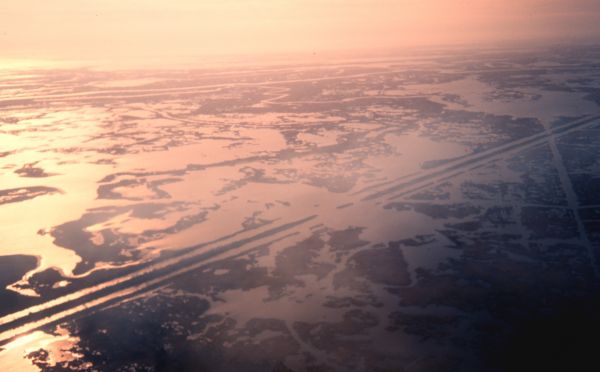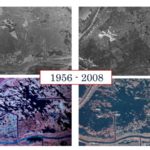
Lawsuits have blamed oil and gas canals for coastal erosion, but they’re not the only culprits
They say a picture is worth a thousand words or, in the case of New Orleans attorneys Gladstone Jones and Jim Swanson, untold damages that are well into the millions.
At the mid-January meeting of the Coastal Protection and Restoration Authority, Louisiana’s guiding coastal board, the two men offered up a PowerPoint presentation with 100 slides. But it was 11 in particular that helped explain the reasons why Jones and Swanson are representing the Southeast Louisiana Flood Protection Authority-East in its suit against 97 oil and gas companies.
They displayed aerial photographs of St. Bernard’s unincorporated community of Delacroix, beginning in the 1950s and ’60s. While trappers and fishermen had come to define the area back then, the discovery of oil and gas in the Gulf of Mexico helped redefine it with canals cut across the marshes.
At first locals thought nothing of it, pleased to have a shortcut through the marsh.
But as the ’60s gave way to the ’70s and ’80s, the photos showed land being transformed into open water along those same canals. By the time the two men got to their slide of 2008, they had a compelling argument against companies like Devon Energy and Murphy Oil, saying they were liable for decades of land loss and on the hook for picking up the tab — basically the same argument being put forth by the New Orleans-area levee board.
Why has St. Bernard Parish lost nearly 30,000 acres of marsh since 1930? Oil and gas canals, Jones told members of the CPRA.
Unconvinced, many board members urged him to bring the presentation to a speedy conclusion.
While critics can point to dozens of studies — conducted by a variety of sources ranging from the Mineral Management Service and Louisiana Geological Survey to the Army Corps of Engineers and Louisiana Sea Grant — that blame oil and gas activities for coastal losses, architects of Louisiana’s Master Plan for coastal restoration counter the studies overstate their point.
In the game of blame, CPRA Chairman Garret Graves is more keen on wagging a finger at the Corps of Engineers. He argues that damage done by the Corps in leveeing and mismanaging the Mississippi River was significantly more damaging than oil and gas canals.
“If these river levees were not put there, these oil field canals, which, based on what we know now were ill-advised practices, they would have filled in,” Graves said.
The leveeing off of the Mississippi stopped the river water from running its course, and sediment was blocked, thus stalling the natural land-building process. Graves estimates the Corps’ levees cause billions in damage annually.
That’s one of the reasons he convinced the CPRA to file its own lawsuit against the Corps to have it to take full responsibility for a $3 billion restoration job involving the Mississippi River Gulf Outlet, and the operation and maintenance of the Algiers Canal hurricane levees.
Supporters of the Graves approach argue that effort directly conflicts with the suit brought about by the Southeast Louisiana Flood Protection Authority-East, which demands that oil and gas companies immediately restore damages to wetlands caused by decades of energy exploration.
“The lawsuit the flood authority filed attempts to hold the oil and gas industry accountable for what are responsibilities of the Corps of Engineers,” Graves said.
That could create a scenario — possibly — where the first to win a court decision affects the other. With 97 defendants weighing down the flood authority’s suit, that gives the CPRA a head start.
“If we’re successful, it’ll knock the wind out of their sails,” said House Natural Resources Chairman Gordon Dove, R-Houma, also a CPRA member.
Another pending legal question involves what happens if and when the CPRA suit is successful. While CPRA boosters argue the Corps could simply move forward with the work, others like John Barry of Restore Louisiana Now believe Congress will have to approve a separate appropriation.
“I wouldn’t hold my breath for that,” said Barry, the former vice chairman of the flood authority who helped file the suit against oil and gas companies before being removed by an angered Gov. Bobby Jindal. “But I do applaud their effort to hold the Corps accountable.”
Barry said he believes the lawsuit from the levee authority might never actually make it to court.
State officials, though, aren’t as complimentary of the flood authority’s suit.
“It’s safe to say the case does conflict with our legal strategy,” said Graves, who recently announced he might ask CPRA to file yet another suit to block the levee authority’s legal proceedings.
That’s all to say there are differing opinions on the overall impact canals have had on coastal land loss.
Subsidence and sea level rise are also well-known culprits.
Tim Osborn of NOAA’s Office of Coast Survey for the Eastern Gulf in Lafayette, recently took a flight over south Plaquemines Parish, and he marveled at the amount of water that has been opened up by man-made channels, slips and canals. He observed that there is literally no interior that is protected from wave action, tidal exchange or intrusion of saltwater at the parish’s bottom.
While relative sea level rise played its part in doing this, as seen in more than 100 years of scientific research, the nearby oil and gas activity has helped things along.
“The impact of oil and gas canals, pipeline canals and navigation channels works to speed up this process in breaking up and weakening the wetland areas,” Osborn said. “The relative sea rise of over 3 feet in the next 75 to 90 years will impact most of the 12,000 square miles of coastal zone of the state.”
Also speeding up the process are dams upriver, invasive species like nutria, hurricanes, the 2010 oil spill and other factors. They’re all acting in concert, although piles of studies still blame the bulk on the energy industry.
The real question is what can be done in the short and long terms.
Jones and Swanson have asked CPRA to support the formation of a task force to address industry responsibility. They also asked the board to “support aggressive enforcement of permits and regulations.”
In that vein, the parish councils in Jefferson and Plaquemines parishes have filed lawsuits — yes, more legal action — against oil companies, alleging they violated the terms of their leases and drilling permits, thus causing land loss and saltwater intrusion.
The suits are not as broadly drawn as the one against 97 oil companies filed by the Southeast Louisiana Flood Protection Authority-East, according to the attorney.
“They are very narrowly tailored to address only violations of coastal zone regulations and the coastal zone statute, and nothing else,” said Vic Marcello of Talbot, Carmouche and Marcello, the lead law firm in the legal action.
“Hopefully, this will start the process of discussions and negotiations with the oil companies,” Jefferson Parish President John Young said in an earlier interview.
One swift reaction to the dredging of canals would be backfilling. Yet, in some instances, more than a few recreational fishermen would hate to lose some of the canals, where speckled trout are known to stack up.
Nonetheless, the idea hasn’t caught on in a real way with the state, and doesn’t seem to be a priority in coastal restoration planning — not in the same way as, say, sediment diversions.
The state’s coastal officials are looking into various avenues for filling canals, and they do get filled occasionally when nearby projects are being constructed.
But the evidence to justify backfilling is mixed, and a proactive approach by industry could be interpreted as an admission of guilt, a sign the canals were in someway sinister after all, according to some.
When canals of yesteryear were first dredged, the material that came out was stacked on the sides. That material, mini levees in a way, are referred to as spoil banks.
About 13 years ago, various groups teamed up to fill canals in Jean Lafitte State Park, using one process that pushed spoil banks back into the canals. Today, however, noticing any real changes to the land from the different applications is difficult.
So, given the way the issue has developed over the past year, with lawsuits progressing more feverishly than policy ideas and administrative actions, it might very well end up being the courts that ultimately weigh in on the canals and what should be done.
But by all indications, it will not bring a conclusion to this segment of the coastal blame game.




